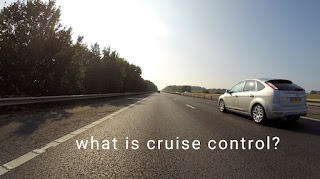What is cruise control?
Cruise control (now
and then known as speed control or autocruise, or tempomat in certain nations)
is a framework that naturally controls the speed of an engine vehicle. The
framework is a servomechanism that assumes control over the choke of the
vehicle to keep a consistent speed as set by the driver.
How cruise control works?
While driving on an open street for quite a while, it would
be really tiring to continue to press the gas pedal. Cruise control is a
component that lessens such weakness drivers would feel while driving a
significant distance. The framework mimics the manner in which human drivers
drive. In any case, rather than squeezing the gas pedal, it utilizes an
actuator to control the choke and helps your vehicle keep cruising at a similar
speed.
The cruise control framework utilized in more seasoned
vehicles is associated with the gas pedal through a link to keep up with the
gas pedal in a specific situation to keep the pre-set speed. Though the
framework in fresher vehicles electronically deals with the speed through a
program without a link. All things considered, a PC associated with different
sensors and choke controls works the element through a remote framework. This
more up to date innovation can consequently change the speed dependent on how
quick the vehicle ahead is going while at the same time keeping a protected
separation. It significantly lessens drivers' weariness since drivers don't
need to press and delivery the gas pedal over and over. Drivers will discover
the framework especially valuable on parkways or streets with gridlocks during
busy time.
How to operate cruise control?
The driver should update the vehicle physically and utilize
a catch to set the cruise control to the flow speed.
The cruise control takes its speed signal from a turning
driveshaft, speedometer link, wheel speed sensor from the motor's RPM, or from
inner speed beats created electronically by the vehicle. Most frameworks don't
permit the utilization of the cruise control under a specific speed - normally
around 25 or 30 mph (40 or 48 km/h). The vehicle will keep up with the ideal
speed by pulling the choke link with a solenoid, a vacuum-driven
servomechanism, or by utilizing the electronic frameworks incorporated into the
vehicle (completely electronic) in the event that it utilizes a 'drive-by-wire'
framework.
All cruise control frameworks should be equipped for being
wound down both expressly and consequently when the driver pushes down the
brake, and regularly likewise the grip. Cruise control frequently incorporates
a memory highlight to continue the set speed subsequent to slowing down, and a
coast highlight to decrease the set speed without slowing down. At the point
when the cruise control is locked in, the choke can in any case be utilized to
speed up the vehicle, however when the pedal is delivered the vehicle will
then, at that point delayed down until it arrives at the recently set speed.
On the most recent vehicles fitted with electronic choke
control, cruise control can be coordinated into the vehicle's motor
administration framework. Current "versatile" frameworks incorporate
the capacity to consequently lessen speed when the distance to a vehicle in
front, or as far as possible, diminishes.
Pros and Cons of cruise control:
-
A few benefits of cruise control include:
· It is
valuable for lengthy drives (lessening driver exhaustion, further developing
solace by permitting situating changes all the more securely) across roadways
and meagerly populated streets.
· A few drivers
use it to try not to abuse speed limits. A driver who in any case will in
general unwittingly speed up throughout a thruway excursion may abstain from
speeding.
· Expanded
eco-friendliness
Nonetheless, when utilized mistakenly cruise control can prompt
mishaps because of a few elements, for example,
· Perilous
climate conditions
· Speeding
around bends that require easing back down
· Unpleasant
or free landscape that could contrarily influence the cruise control controls
· Urges
drivers to try to ignore driving, expanding the danger of a mishap
· Hazard of SUA (Sudden Unintended Acceleration) and potential mishaps. Driver having feet very still loses spatial insight and, in the event of a traffic crisis, hits the gas pedal rather than the brakes.
Is cruise control useful for your vehicle?
Is cruise control awful for your vehicle? By no means.
Speed increase that costs fuel additionally causes mileage on the driveline, so
cruise control is useful for the vehicle.
What is the advantage of Cruise control?
Advantages of Cruise Control
Since cruise control permits drivers to keep their vehicle
at a steady speed, there is less danger of the driver speeding up and speeding
past different drivers. Furthermore, cruise.
Does cruise control hurt your vehicle?
Setting your cruise control on as far as possible on a
lengthy, difficult experience trip is an extraordinary method to assist you
with keeping a protected speed and stay away from a speeding ticket;
notwithstanding, if your movements incorporate any winding streets or moving
slopes, utilizing cruise control can really expand your chances of getting into
a mishap and surprisingly squander your fuel.
How does cruise control hinder vehicle?
How does cruise control really control the vehicle's speed?
Cruise control controls your vehicle's speed (take a stab at saying that
multiple times quick) in the very same way you do: by means of the choke. Yet,
in the two situations the framework is intended to increment or diminishing the
motor's force, which accelerates or eases back the vehicle down.

